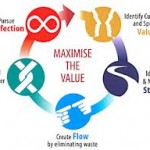
Identify Customers and Specify Value
Only a small fraction of the total time and effort in any organisation actually adds value for the customer. In this step, you define Value for a specific product or service from the customer’s perspective. All the non value activities – or waste – can be then be identified for removal.
Identify and Map the Value Stream
The Value Stream is the entire set of activities across all parts of the organisation that come into play when delivering the product or service. This represents the end-to-end process that delivers the value to the customer. Once you understand what your customer wants, the next step is to identify how well you are interacting with and delivering to them.
Create Flow by Eliminating Waste
You generally find that once the Value Stream has been mapped, only a very small fraction of activities add real value. This fraction tends to be in the 5%-40% range depending on the kind of product or service that is being offered. Getting rid of the redundant activities ensures that your offering “flows” to the customer smoothly without interruptions or delays.
Respond to Customer Pull
This is about understanding the customer requirement in terms of priorities, benefits and timescales and then creating a process that fits with that.
Pursue Perfection
Responding to the customer better by eliminating waste and redundant processes is of course a series of iterative improvements, or steps, but as all these steps start to take effect, the overall effect has more impact than a simple aggregation of small improvements.